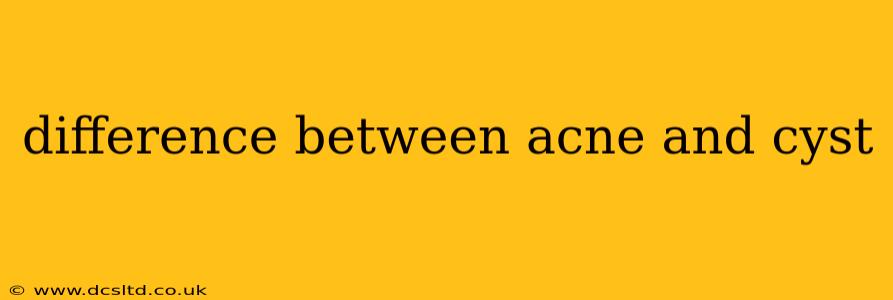Acne and cysts are both skin conditions that can cause bumps and blemishes, leading many to confuse the two. However, while they share some visual similarities, they differ significantly in their underlying causes, appearance, and treatment. Understanding these differences is crucial for effective management and preventing potential complications.
What is Acne?
Acne vulgaris, commonly known as acne, is a chronic inflammatory skin condition affecting the pilosebaceous units – the hair follicles and their associated sebaceous glands. It's characterized by the development of various lesions, including:
- Comedones (blackheads and whiteheads): These are clogged pores caused by a buildup of sebum (oil), dead skin cells, and bacteria. Blackheads are open comedones, appearing dark due to oxidation, while whiteheads are closed comedones, appearing as small, white bumps.
- Papules: Small, raised, red bumps that are inflamed.
- Pustules: Papules containing pus.
- Nodules: Larger, deeper, and more painful lumps that are often inflamed and can leave scars.
- Cysts: While cysts can be a severe form of acne, they differ significantly from the cysts discussed below, in their formation and treatment. Acne cysts are usually painful, filled with pus, and can leave scarring.
Acne is primarily caused by hormonal fluctuations, genetics, and bacterial overgrowth (often Cutibacterium acnes). It's most common during puberty but can persist into adulthood.
What is a Cyst?
A cyst is a closed sac-like structure that's typically filled with fluid, semi-solid material, or air. Cysts can occur in various parts of the body, including the skin. Unlike acne, skin cysts are not directly caused by clogged pores and bacteria. They can arise from:
- Blocked glands: A blocked sebaceous gland or other gland can lead to cyst formation.
- Infections: Sometimes, an infection triggers cyst development.
- Trauma: Injury to the skin can sometimes initiate cyst growth.
- Genetic factors: Some cysts have a genetic predisposition.
Skin cysts often appear as a round or oval lump beneath the skin's surface. They can vary in size and may be painful or asymptomatic. They may also be filled with a thick, cheesy material.
Key Differences Between Acne and Cysts
| Feature | Acne | Cyst |
|---|---|---|
| Cause | Clogged pores, bacteria, hormonal changes | Blocked glands, infection, trauma, genetics |
| Appearance | Comedones, papules, pustules, nodules, cysts | Round or oval lump under the skin |
| Contents | Sebum, dead skin cells, bacteria, pus | Fluid, semi-solid material, or air |
| Depth | Varies, can be superficial or deep | Usually deeper than most acne lesions |
| Pain | Varies, from mild to severe | Can be painful or painless |
| Treatment | Topical treatments, oral medications | Drainage, surgical removal, sometimes antibiotics |
| Scarring | Possible, especially with severe acne | Possible, especially if infected |
What are the different types of cysts?
Several types of skin cysts exist, including:
- Epidermoid cysts: These are common, benign cysts containing keratin. They often feel firm and may have a small, dark pore on the surface.
- Pilar cysts (trichilemmal cysts): These are found on the scalp and are filled with keratin.
- Sebaceous cysts: These develop in sebaceous glands and often contain a yellowish material.
How are acne and cysts treated?
Treatment depends on the specific condition and its severity. Acne treatment typically involves topical medications (retinoids, benzoyl peroxide), oral antibiotics, or hormonal therapies. Cysts may require drainage by a dermatologist, surgical removal, or antibiotic treatment if infected. Always consult a dermatologist for proper diagnosis and treatment of both acne and cysts.
Can a cyst be a form of acne?
While severe acne can include cysts, the acne cyst is fundamentally different from other types of skin cysts. Acne cysts develop within the pilosebaceous unit, stemming from inflammation, whereas other cysts arise from various other causes.
What are the complications of leaving acne and cysts untreated?
Untreated acne can lead to scarring and hyperpigmentation. Untreated cysts can become infected, leading to pain, swelling, and potentially more serious complications. Prompt medical attention is crucial for managing these conditions effectively.
This information is for general knowledge and should not be considered medical advice. Always consult a dermatologist or healthcare professional for diagnosis and treatment of skin conditions.
